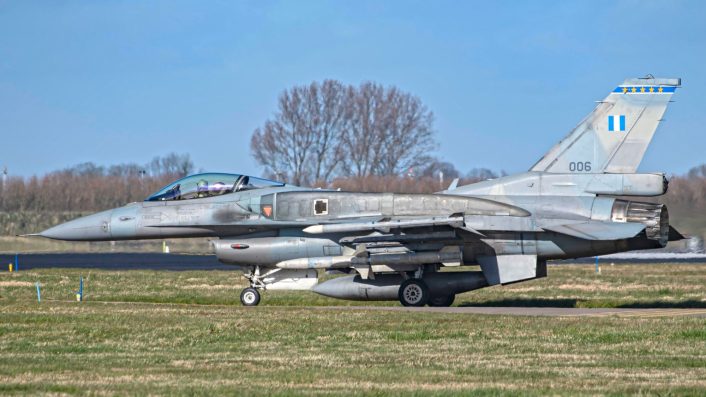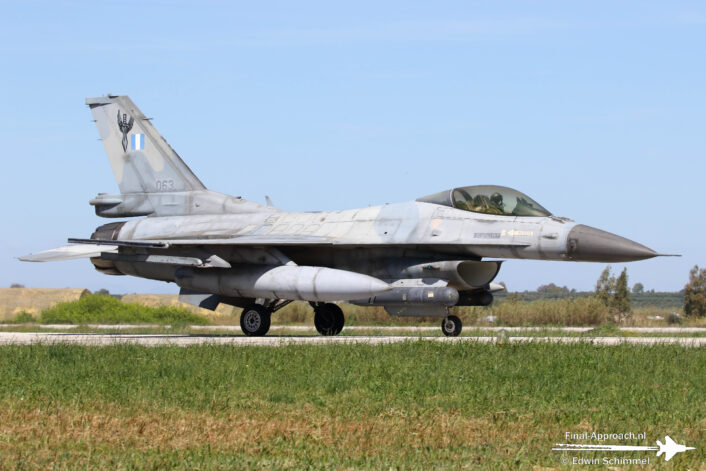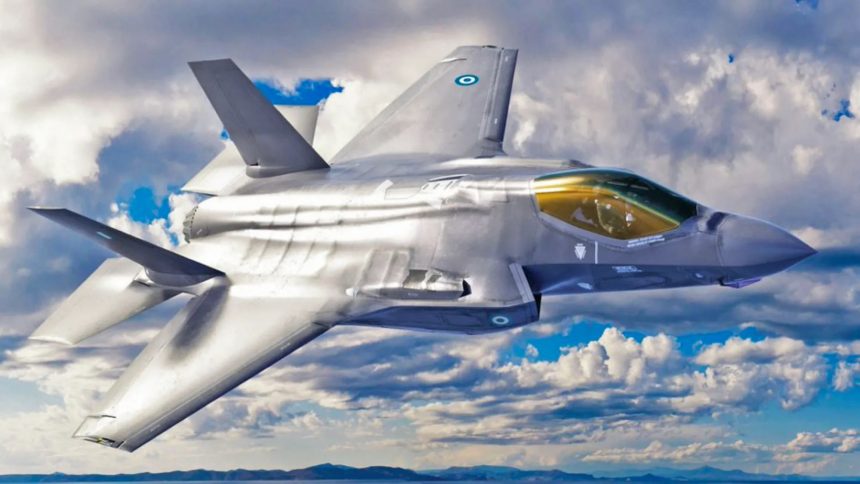Talks with Lockheed Martin to upgrade Greece’s 38 F-16C/D Block 50s remain stalled, while new jets won’t arrive before 2031 and will need upkeep soon after.
Reports from Greece have again emerged saying the country might go for an additional order of F-35A Lightning II stealth fighters, in addition to the 20 it signed on for in 2024. This is because of the “slow” pace of the five-year-long negotiations with Lockheed Martin for the upgrade of its 38 F-16C/D Block 50 fighters, in service since 1997.
The upgrade might not happen before the end of the decade (possibly 2031-32), and would still deliver a relatively obsolete variant, not fully optimized to team up with the F-35A and the Rafale, according to Ekathimereni and Greek Reporter. Rather, its 83-84 F-16 Block 52/52+ currently being upgraded to the F-16V Viper Block 72 standard, 40 of which have been delivered so far as per Opex360, would be more suited for the role.
Greece signed on Jul. 25, 2024, a Letter of Acceptance (LOA) for 20 Lockheed Martin F-35A Lightning II aircraft under the U.S. FMS (Foreign Military Sales) route in a $3.5 billion deal. The LOA included an option for an additional 20 aircraft, which Athens is now considering, as per the reports. It must however be noted that no final decision has been announced, as other reports said that negotiations are in the final stage.
🇬🇷Athens is considering expanding its stealth fighter program by ordering 12 more F-35 jets, on top of the 20 already under production for the Hellenic Air Force, with the first expected for delivery in 2028.
By the end of the decade, Greece expects to field 209 fighter jets:
8… pic.twitter.com/iSlHbdCBPq
— Ictinus ®️ (@ictinus_x) September 12, 2025
HAF F-16 upgrade plans
The HAF is currently upgrading 84 of its F-16C/D Block 52+ aircraft to the F-16V Viper Block 72 configuration, as per a 2018 contract to Lockheed Martin. The F-16V Viper designation is given to aircraft upgraded to the Block 70/72 standard, rather than newly built airframes. This upgrade program will continue until 2027.
The HAF’s F-16V Vipers would have the APG-83 AESA radar, Modular Mission Computer, enhanced avionics, Automatic Ground Collision Avoidance System and improved cockpit displays and controls, “making Greece’s F-16V fleet among the most advanced in Europe,” Lockheed Martin’s vice president of strategy and business development Mara Motherway’s statement to Ekathimereni on May 14, 2025, on the sidelines of DEFEA 2025.
Παραλαβή των 2 Πρώτων Εκσυγχρονισμένων Αεροσκαφών F-16 Viper pic.twitter.com/YQ1vFibYoh
— Hellenic Air Force (@HAFspokesperson) September 13, 2022
The HAF originally planned to upgrade all of its 121-122 Block 50/52+/52+ Advanced to the F-16V Viper Block 70/72 standard. However, it then decided to include only the Block 52+ and Block 52+ Advanced variants in the program, and then undertake an in-house upgrade of the 38 F-16C/Ds Block 50s by using equipment removed from the Block 52 airframes during the Viper Block 70 upgrade.
Hellenic Aerospace Industry (EAB) was to collaborate with Lockheed Martin on this front. This would have brought the Block 50s to the Block 50M (Modernized) or the Block 52+/Block 52+ Advanced standard, with the structural SLEP (Service Life Extension Program) adding 2,000 more flight hours.

Veteranos reported in May 2022 these 38 F-16C/D Block 50s, assigned to the 111th Fighter Wing’s 341st Squadron “Velos” and 347th Squadron “Perseus” – involved in the periodic interceptions with Turkish Air Force F-16s, would have “dramatically increased” capabilities. The fate of the older F-16C/D Block 30s acquired in the late 1980s, in service under the HAF’s 111th Wing, is not clear.
Obsolete upgrades
Ekathimereni said that the “possibility of activating the option to procure […] 8-12 more F-35s […] after 2030 instead of upgrading the 38 F-16 Block 50 to Block 52 standards is now being examined with particular attention,” parallel to the “slow” inconclusive five-year-old negotiations.
The May 2025 Ekathimereni report, that touched upon the “slow but steady progress” in the talks and a visit by the HAF General Staff chief Lt. Gen. Dimosthenis Grigoriadis to the United States later that month, also shed light on how the lower price point would trade off vital upgrades.
F-16 Block 50: Η Πολεμική Αεροπορία προχωρά χωρίς παρεκκλίσεις το πρόγραμμα αναβάθμισης για τα 38 μαχητικά https://t.co/oFtteljzDR
— Kostas Sarikas 🇬🇷 (@SarikasKostas) September 15, 2025
“Consultations […] focused on drastically reducing the cost. The two sides are working on ways to contain costs [by] prioritizing systems that are considered essential. [But this] should not affect the interoperability of the fighter jet, since this would nullify the purpose of the upgrade,” added the report.
Greek Reporter, while putting the amount Lockheed Martin agreed to at $980 million, much lower than the initial estimate of $2.1 billion, also added how the new SLEP-configured Block 50s would need “further interventions” by the “end of the next decade.”
“This is the main reason that has led the Greek side to consider the possibility of simply adding some more F-35s to the Hellenic Air Force fleet, which, in any case, will have multiple capabilities and will be operationally active for another half a century, in contrast to the upgraded F-16 Block 50s,” Ekathimereni latest report added.

OnAlert however reported on Sep. 15: “Negotiations between the Air Staff and the US side are now at an advanced stage, while the program has received the green light from both the military and political leadership. Everything is proceeding according to plan, top military sources clarify, and the sending of the Letter of Request (LOR) to the United States in the coming months will mark the official start of one of the most important armament programs of the last decade.”
Greek F-35As
To operate and sustain its current buy of 20 F-35As, slated to be delivered from 2028, the Greek government has also undertaken a series of infrastructure upgrade work. According to the Greek City Times, Andravida Air Base will undergo a “NATO standard […] €300 million modernization” featuring new facilities like “reinforced aircraft shelters, advanced surveillance systems, fiber optic networks, and a rebuilt control tower.”
The upgrade plan, developed in collaboration with the U.S. Air Force, involves phased construction and stringent certification processes. Fourteen HAF pilots and 60 technicians were also scheduled to join the F-35 Joint Program Office in Virginia for specialized training by summer of this year.
The Hellenic Air Force is set to begin training its first F-35 pilots by September, with 14 pilots and 60 technicians heading to the United States this summer.https://t.co/Pe47yJuMOq pic.twitter.com/GqEWp5IOKl
— Ictinus ®️ (@ictinus_x) April 25, 2025
Motherway had told Ekathimereni in May 2025 that the production of the Greek F-35s would begin as a part of the Lot 20 order, with the first delivery in late 2028 and the first aircraft arrival in Greece by 2030. “All of Greece’s jets will be in the latest available configuration,” Motherway had said, referring to the TR3 (Technology Refresh 3) software code to enable the Block 4 upgrades.
Strengthening alliances, securing the skies. 💪✈️
Europe’s skies are safer with the F-35. For Greece and NATO allies, it’s a game-changer for interoperability, sovereignty and readiness. pic.twitter.com/ZW8gLxbXV9
— F-35 Lightning II (@thef35) September 6, 2025
Rafales
As for the Rafales, we reported Greek Prime Minister Kyriakos Mitsosakis’ wide-ranging interview to Defence Review in November 2024, where he revealed that Athens will not buy more of the French jets, and will continue with its fleet of 24 aircraft. As mentioned earlier, the same interview also revealed Greece’s plan to consider buying more F-35As – either all of the optional 20 or some of them.









